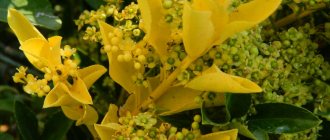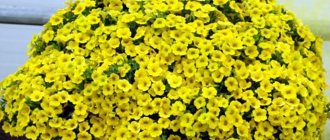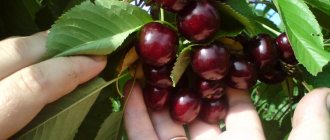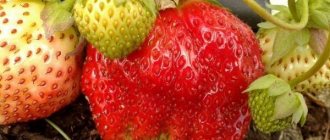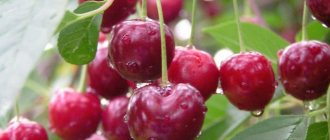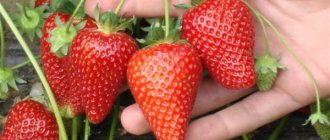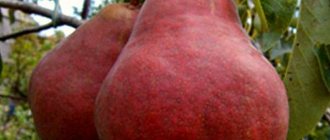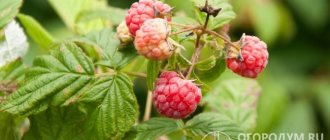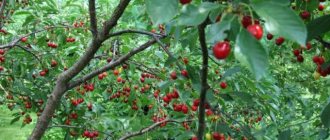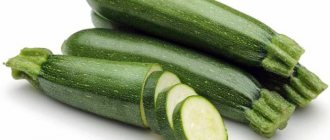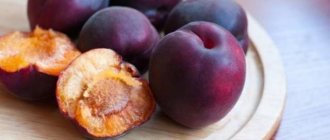Until now, I associate May with three plants: apple tree, lilac and viburnum. Soon, at the end of this month, the last bell will ring in schools, and teachers will receive luxurious May bouquets from grateful students.
Until now, I associate May with three plants: apple tree, lilac and viburnum. Soon, at the end of this month, the last bell will ring in schools, and teachers will receive luxurious May bouquets from grateful students. I remember that on this day the pupils always gave my mother lilacs and viburnum Buldonezh, the snow-white balls of which seemed unusually beautiful and almost fabulous to me, then a little girl.
On the southern coast of Crimea, the first viburnums bloom very early: from mid-December, but the peak of their snow-white, pink flowering occurs in May, so it was in this month, ignoring the time frame, that I tried to collect all the most interesting types of viburnums and talk about their decorative qualities and characteristics of cultivation. So, let's get acquainted.
Viburnum avabuki
The Japanese evergreen “stately” beauty - viburnum awabuki (Viburnum awabuki) comes from Japan and South Korea. It is tall, up to 4 m and long-lived. The leaves are large and shiny. The flowers are white, collected in loose, drooping inflorescences; bloom in May-June. It bears fruit regularly in September, but produces few viable seeds.
Features of cultivation
Relatively winter-hardy species. On the Black Sea coast of the Krasnodar Territory, during severe winters with an absolute minimum of -10-11°C, only the leaves are damaged to a greater or lesser extent. On the southern coast of Crimea, in cold winters, the ends of annual shoots freeze, with the loss of most of the leaves. Tolerates partial shade, but for abundant flowering it requires a sunny location and moderately moist, fertile, clay soils. Resistant to pests. Propagated by cuttings. A good plant for exotic groups and hedges.
Viburnum care
This is an unpretentious plant, so there should not be any difficulties. If dry weather stagnates, you will need to water it yourself, but if it rains regularly, the soil will be moistened without the intervention of the gardener. If mulching has not been done, weeding may be necessary; in the fall, be sure to dig once near the trunk and it is advisable to mulch this area.
Once every three years you need to add 4 kilograms of compost. To increase productivity, in the spring you will need to fertilize with ammonium nitrate (30 grams), and in June, watering with minerals is applied. It is also necessary to monitor the appearance of the bush every year, trimming old, frail and dried branches.
Barkwood Viburnum
Snow-white beauty (during flowering) - Barkwood viburnum (Viburnum x burkwoodii) is a garden hybrid of Carls viburnum and useful viburnum. It is a semi-evergreen shrub 2.5 m high and wide. The leaves are longitudinally wrinkled, up to 10 cm long. The flowers are pinkish-white, fragrant, in large umbellate inflorescences, up to 9 cm in diameter. Blooms in spring; fruits are rarely produced. Decorative forms are available.
Features of cultivation
Propagated by cuttings. Prefers light shade and well-drained, fertile soils. A good plant for small groups and close-in tapeworms.
Viburnum bodnant
A very difficult to pronounce species is bodnant viburnum (Viburnum x bodnantense), which, like the previous one, is a garden hybrid, but of fragrant viburnum and grandiflora viburnum. This is a deciduous shrub up to 3 m high, growing up to 2 m in width. Leaves are up to 10 cm long, young bronze. The flowers are light pink, collected in apical corymbs, up to 7 cm in diameter. Fruits are rarely set. There are decorative forms, the most interesting among them is 'Dawn' (dark pink flowers, collected in convex corymbose inflorescences, white when flowering).
Features of cultivation
Propagated by cuttings. Grows well in sunny places and in partial shade; prefers fertile, loose soil. Good in small groups in the background.
Viburnum varieties for central regions
In the center of Russia, varieties such as Zholobovskaya, Souzga, Ulgen and Taiga rubies will perform better in terms of yield and marketability of berries.
Viburnum variety Zholobovskaya - obtained by selection among viburnum seedlings in the wild. The fruits are ready for harvest in mid-September. Plants of this variety are shrubs with a very compact crown. When planting as two-year-olds, the first fruits can be obtained in the third or fourth year. The berries are collected in an umbrella-shaped shield, they are slightly elongated and have a spherical shape and a bright red color.
The average weight of the berries is about 0.58 g, each has quite juicy pulp with a barely noticeable bitterness; we can say that the fruits are sweet. The tasting score is about 4.1 points, which is a very good indicator for viburnum. Each viburnum fruit contains up to 18% dry matter, more than 11% sugars, about 1.5% acids, up to 115 mg% ascorbic acid and over 715 mg% P-active compounds. The maximum yield of the variety is about five kilograms per bush. Alas, the variety requires pollinators and needs additional watering.
Viburnum Souzga , - a variety obtained by selection among wild viburnum seedlings. The fruits ripen towards the end of September. Plants of this variety are quite compact bushes that produce the first harvest 3-4 years after two-year-olds are planted on the site. The berries are arranged in an umbrella-shaped shield; they have a spherical shape and a rich red color when fully ripe.
The average weight of the fruit is about 0.66 g, all of them have juicy pulp, with a barely noticeable bitterness. The taste is rated by tasters at 3.7-3.9 points. Each fruit contains up to 10% sugars, about 1.9% acids, more than 137 mg% ascorbic acid and over 580 mg% P-active compounds. The maximum yield reaches 6.6 kg per bush. Alas, the variety is self-sterile, requires the presence of pollinating varieties on the site and needs additional irrigation.
Viburnum variety Zholobovskaya. © Nikolay Khromov
Viburnum variety Souzga. © Nikolay Khromov
Viburnum variety Ulgen - this variety was obtained by selection among seedlings grown in nature. The fruits ripen around mid-September. Plants of this variety are shrubs that have a compact crown and begin to bear fruit in 3-4 years, when planted as two-year-olds. The berries are arranged in an umbrella-shaped shield; they have a spherical-elliptical shape and a deep red color.
The average weight of the berries is about 0.69 g, each has juicy pulp with a slightly bitter aftertaste. The taste is rated 4.1 points by tasters. Each fruit of this variety contains up to 12.5% sugars, about 1.9% acids, more than 129 mg% ascorbic acid and up to 560 mg% P-active compounds. The maximum yield per bush is about four kilograms. Alas, the variety is self-sterile, requires the presence of pollinating varieties on the site and needs additional irrigation.
Viburnum Taiga rubies , - this variety was obtained by selecting among seedlings from free pollination of the common viburnum. The fruits ripen towards the beginning of September. Plants of the variety are typical shrubs, reaching a height of three meters and having a crown of the same diameter as the height of the plant. The fruits are arranged in an umbrella-shaped shield, they have a spherical shape and reach a mass of 0.51 g.
Each berry contains up to 9.6% sugars, more than 1.5% acids, about 130 mg% ascorbic acid and up to 668 mg% P-active compounds. The taste is bitter, but sweetness is also felt, so tasters rate the taste at 3.4-3.6 points. The variety reproduces well by green cuttings, gives a yield of about three kilograms per bush and requires additional watering.
Viburnum variety Taiga rubies. © Nikolay Khromov
Viburnum variety Ulgen. © Nikolay Khromov
Kalina Gordovina
Many people know the viburnum viburnum (Viburnum lantana). It is native to Europe, North Africa, and Southwest Asia. This is a deciduous shrub 2-4 m high. The leaves are rounded-ovate, up to 12 cm long. The flowers are creamy-white with a subtle pleasant aroma, collected in inflorescences - convex umbrella-shaped panicles, up to 10 cm in diameter; bloom in May. The fruits initially turn red and, as they ripen, acquire a blue-black color with a light coating. They are larger than the fruits of other types of viburnums, reaching a length of 12-15 mm. They ripen in September-October and are pecked very quickly by birds.
Features of cultivation
Viburnum is of medium growth rate, shade-tolerant, frost-resistant, can withstand frosts down to -23-25°C (at lower temperatures the leaves freeze). Tolerates saline soils, is drought-resistant, but grows better when watered. Blooms and fruits profusely in sufficiently moist, fertile, regularly cultivated soil. Known for its tolerance to a variety of conditions. Can be used for single and group planting in open areas and in partial shade. Slightly damaged by pests. Propagated by seeds, cuttings and layering. Seed germination lasts for 2 years. Before sowing, it is recommended to stratify the seeds at 5-10°C for up to 3 months. There is also information about possible thermal stratification at the same time. Seed placement depth is up to 3 cm. One of the most decorative shrubs with beautiful foliage, inflorescences and fruits, suitable for planting in summer cottages in tapeworms and groups.
Unusual and original
Unusual varieties of viburnum are often used as ornamental shrubs and are active participants in landscape design.
viburnum gordovina” width=”600″ height=”450″ />
Gordovina
The chokeberry viburnum Gordovina is characterized by the high size of the bush, because an adult plant often grows up to 5 meters. The berries fully ripen in September and change from red to black.
Serrated
The dense crown and large size of the bush indicate jagged viburnum. It grows up to 5 meters in height. Endowed with beautiful serrated foliage with original deep slots. Fruits with blue berries.
Canadian
Tall tree, up to 6 meters. Blooms with small white flowers. Fruits with blue berries.
Forked
The extraordinary Forked viburnum receives special attention from gardeners. In the spring, its foliage with original patterns turns red, in the summer it changes to green, and in the fall - to a spectacular lilac. Fruits with red berries.
Wrinkle-leaved
The evergreen Viburnum Wrinkle-leaved grows up to three meters. Endowed with heavily pubescent shoots and thick, wrinkled leaves. Fruits with black berries 0.7 cm long.
Sargent
A highly spreading branched shrub up to 4 meters high. Blooms in May. The rich red berries ripen in early October.
Folded
The stepped arrangement of branches and spectacular velvety leaves distinguish the Folded Viburnum from other varieties. Grows up to three meters high. There are two forms: tall and long-flowering.
Laurel leaf
The evergreen viburnum Laurel leaf grows up to 3 meters in height. Blooms with fragrant flowers with a pink tint. Fruits with dark blue berries.
David
This evergreen shrub grows no higher than one meter. It blooms with beautiful flowers with a delicate pinkish tint. Fruits with blue berries.
Buldenezh
Viburnum Buldenezh is a spreading bush up to 4 meters in height. Lives up to 50 years and is distinguished by long flowering, which lasts a whole month. Flowers are distinguished by their lack of smell.
Repair room
Many varieties of viburnum, when grown in regions with mild climates, bloom twice per season. For example, Viburnum folded Watanabe. It blooms for the first time in June and blooms again in October.
Kalina David
Chinese evergreen beauty - David's viburnum (Viburnum davidii); homeland: Western China. This is a compact, squat shrub, 1-1.5 m high and wide. The leaves are like those of a plantain, up to 15 cm long. The flowers are white, in sparse, corymbose inflorescences; bloom in late spring. Rarely bears fruit.
Features of cultivation
Propagated by cuttings. Prefers shady places with moderately moist and fertile soil. An original plant for shady gardens.
Viburnum fragrant
And again, the eastern viburnum is the fragrant viburnum (Viburnum odoratissimum) native to the Southeast Himalayas and Central China. This is a large evergreen shrub, up to 5 m high and wide. The leaves are thick, glossy, elongated oval, up to 20 cm long. The flowers are white, fragrant, collected in round racemes, 8-10 cm long. Red fruits are rarely formed.
Features of cultivation
Low winter hardiness: can withstand temperatures down to -5 degrees C. Propagated by cuttings. Prefers shaded locations with moist, fertile, clayey, acidic soils. A beautiful plant for small groups and as a tapeworm under the canopy of tall trees.
Kalina Karlsa
Eastern beauty - Carl's viburnum (Viburnum carlesii); homeland: Korea, Japan. A small deciduous shrub up to 2 m high and wide. The leaves are ovate-oval, wrinkled. The flowers are white, as if sculpted from wax, collected in sparse corymbose inflorescences, with a very delicate scent; They bloom before the leaves bloom, in April-May. Fruits are rarely produced. There are decorative forms, the most decorative being 'Aurora' (the bush is more compact, the flowers are pale pink). The fruits are blue-black drupes that ripen in September-October.
Features of cultivation
In Eastern Europe, where Karls viburnum is widely used in landscape design, it tolerates frosts down to -30°C. Prized for its fragrant pink flowers in early spring, orange-red leaves and blue-black fruits in autumn. Good for solitary and group plantings. It is not demanding on lighting conditions, but the most luxuriant flowering is observed in partial shade, on fertile, well-drained soils. Propagates well by grafting on the crown, by seeds and cuttings. Sowing in autumn after harvesting or in spring with stratification. Without it, the emergence of seedlings is delayed up to 2 years. Resistant to pests.
Proper pruning of viburnum
Viburnum is a fast-growing plant. Over the course of a year, its branches grow by 50 cm, so the bush must be pruned annually. It is recommended to do this in early spring before the start of sap flow, taking into account the following rules:
- be sure to remove dry, damaged, old (over 6 years old) branches;
- Some branches in the center of the crown should be removed to ensure good illumination, on which the viburnum yield depends.
Pruning helps the plant not only develop well and bear fruit, but also allows you to adjust the size and volume of the bush.
With the help of proper pruning, you can form a small tree from a viburnum bush. In this case, the formation is carried out around the selected central trunk, and all lateral branches and root shoots are removed. When an even trunk about 2 m high is formed, they begin to form the crown. To do this, pinch the central trunk so that it begins to branch.
You also need to know some of the features of pruning different varieties of viburnum. For example, if you grow viburnum Buldenezh, then for the future abundant flowering of the seedling in the first year, you need to cut off the inflorescences that appear. This will allow the plant to direct its energies to rooting and strengthening. In subsequent years, it is recommended to prune the bush in the fall so that the plant has time to lay new flower buds for lush flowering next year.
Viburnum cinnamon-leaved
Another Chinese viburnum is the cinnamon-leaved viburnum (Viburnum cinnamomifolium), native to Western China. This is an evergreen shrub with a loose and at the same time columnar crown. The leaves are not typical for viburnums, they are more like the leaves of cinnamon trees: oval-pointed, bent along the central vein, serrated, with arcuate veins, shiny, brownish-green in color. The flowers are inconspicuous, fruits are rarely produced.
Features of cultivation
Not winter-hardy: can withstand temperatures down to -5 degrees C. Propagated by cuttings. It is undemanding to light conditions and needs acidic soils. A unique plant for complex groups.
General information about viburnum
In Russia, viburnum has been known for a long time; it is considered one of the original Russian crops along with rowan and birch. Real breeding work began in our country with viburnum only at the end of the twentieth century, that is, relatively recently.
The very first varieties of viburnum appeared in the State Register of Breeding Achievements in 1995, just 22 years ago, they are still relevant today, these are the cultivars: Zholobovskaya, Souzga and Ulgen. The newest variety was included in the State Register in 2021; this is the Aurora cultivar. In total, 14 varieties of this wonderful crop are currently included in the State Register.
It is interesting that viburnum does not have a strict gradation by region; it is a universal crop that has a set of properties that make it possible to successfully grow one or another variety in regions with completely different climatic conditions.
Conventionally, we can divide the varieties of viburnum available in the State Register into three large groups - those varieties that are more suitable for the northern regions, because they are characterized by high winter hardiness. Varieties that give the best yields in the center with its longer warm period than in the north and plenty of moisture. And varieties that will produce record yields only in the south, where droughts are not so uncommon. As a result, six varieties can be identified and recommended for the northern regions and four varieties each for the center of Russia and the south of the country.
See also our detailed articles: Planting and propagating viburnum and Viburnum - all about growing.
Viburnum large-headed
Very spectacular during the flowering period, large-headed viburnum (Viburnum macrocephalum) is a semi-evergreen or deciduous shrub up to 5 m high and wide. It is a garden hybrid. The leaves are ovate-oval, up to 10 cm long. The flowers are white, sterile (not setting fruit), collected in large, spherical inflorescences, up to 15 cm in diameter! The inflorescences are similar to those of the common viburnum 'Pink'; the same greenish at the beginning of flowering and turning pink when flowering fades.
Features of cultivation
Low winter hardiness: can withstand temperatures down to -5 degrees C. Propagated by cuttings, but poorly. Prefers light shade and moist, fertile, acidic soils. An impressive plant as a tapeworm and for small groups.
Canadian (Viburnum lentago)
This species is most often found in Canada, which explains its name. The best areas where this viburnum grows are hillsides, forest edges, river banks and swamps.
Did you know? In the old days they believed that viburnum protected the house from the evil eye and evil spirits. Therefore, they decorated the hut with clusters and laid out the berries on the table.
It is represented by a tall deciduous or small tree, height - no more than 6 meters. The crown has an ovoid shape, the leaves are wide, oval, pointed.
Their length is 10 cm. In summer they are bright green, and in autumn they become colored in red tones. The flowers are small, creamy white, concentrated in corymbose inflorescences with a diameter of 12 cm. Flowering lasts 2 weeks. The berries are blue-black in color and are suitable for consumption. Growth is quite rapid, it can grow in the shade and is frost-resistant. Quickly adapts to urban conditions.
Laurel leaf viburnum, or evergreen
The Mediterranean beauty is the laurel viburnum (Viburnum tinus), which blooms on the Black Sea coast of the Krasnodar Territory and the southern coast of Crimea from winter to early spring. It is interesting that the ancient Romans used the Latin word tinus to name many plants whose leaves were similar to those of laurel. It is an evergreen shrub, 1-3 m high. The leaves are leathery, sparsely and rigidly pubescent, pointed-oval. The flowers are white, sometimes with a pinkish tint, collected in flat, corymbose inflorescences, 5-10 cm in diameter, which appear on normally developed plants almost all year round, but the most abundant flowering is observed in winter. Viburnum laurel is one of the most common and most resistant winter flowers not only in the Sochi region, but also in Yalta. The fruits are oval-pointed, pearl-blue, and are always produced in abundance, and in the summer this species is a spectacular, beautifully fruited shrub. Decorative forms are available.
Features of cultivation
At a temperature of -15°C it freezes a lot. Tolerates drought well. Propagated by seeds (autumn sowing) or stratified seeds in spring, as well as green cuttings (under glass) and layering. Grows well in light shade, on fertile, loose, neutral soils. It withstands pruning well, is perfectly shaped and used in topiary art. Can be used for solitary and group plantings, borders and low hedges. In some years it is severely damaged by the viburnum whitefly, seaside mealybugs and viburnum bugs.
Breeding Features
When choosing viburnum, take into account the characteristics of the variety. For further cultivation, the soil mixture and place for placing the shrub are carefully selected.
Suitable soil
All varieties are suitable for soil with neutral or slightly acidic acidity levels. It should be loose, not heavy, fertilized with the necessary substances.
For planting, choose a place that is shaded from direct sunlight. For viburnum, moist soil is important throughout the growing season, so shade is a way to avoid rapid evaporation of moisture from the surface of the earth.
Watering and fertilizing
Viburnum needs regular feeding:
- Spring. Includes treatment with urea, potassium sulphide or wood ash.
- Summer. Fertilizing with potassium-phosphorus complex fertilizers.
Every 2-3 years, when replanting and digging up the soil, it is fertilized with compost.
Advice! Summer dry feeding is replaced with liquid feeding in dry, hot weather.
Watering for viburnum is carried out according to the following scheme:
- weekly;
- 3-4 buckets per 1 adult bush.
Dry periods require more frequent watering.
Trimming
To form the crown and increase growth efficiency, 2 prunings are carried out:
- Spring. Sanitary, form-building.
- Autumn. Sanitary, correctional.
Diseases and pests
Viburnum is susceptible to a limited number of diseases. Shrubs rarely get sick, depending on the characteristics of the variety.
- Powdery mildew. This is a fungal infection that spreads gradually. A whitish coating forms on the leaves and moisture accumulates. Shrubs stop blooming and developing. To get rid of infection, the leaves are treated with fungicides.
- Frost burn. A specific disease that is caused by low temperatures. The bark of the trunk cracks, the leaves fade. If damage is detected, they are covered with special mixtures based on liquid clay.
- Fruit rot. A fungal infection that occurs on berries. They become dry, the shell cracks and turns gray. If there are empty cells, instead of fruits, the bush is treated with copper-containing preparations, and damaged fruits are removed individually.
- Viburnum leaf beetle. “Personal” parasite of viburnum - eats leaves, leaving only the central veins. The activity and spread of the leaf beetle leads to the loss of the bush. It is recommended to remove the damaged parts; the remaining bush is treated with karbofos.
- Black aphid. The appearance of a parasite on viburnum can be seen by twisted and discolored leaf blades. They begin to turn brown and dry out. The fight against aphids begins with pruning branches and destroying colonies; the remaining bush is treated with Karbofos.
Viburnum is suitable for growing in summer cottages and household plots, gardens, and park areas.
Viburnum rugosafolia
Another Chinese evergreen beauty is wrinkled viburnum (Viburnum rhytidophyllum), native to Central and Western China. This is a tall shrub (3-5 m), growing up to 4 m in width, with a rather loose, sparse crown. The leaves are large, up to 20 cm long, drooping, with an interesting relief-wrinkled structure. The flowers are small, creamy-white, collected in loose, flattened inflorescences, up to 20 cm in diameter; they are decorative and in the bud stage; bloom in April-May. The blackish-purple fruits set well.
Features of cultivation
Requires moderately moist soils or normal watering during the growth period, semi-shade, protected from drying winds, location, neutral soils. It is the most frost-resistant of all evergreen viburnums. Easily propagated by seeds and vegetatively (cuttings). Effective in single and group plantings. Slightly damaged by pests.
Features of growth and care
Viburnum can grow in forests, ravines and swamps, as well as in gardens and orchards. It reproduces by seeds and root shoots: sometimes it is enough to plant one bush to get several copies in a few years without any intervention. Viburnum tolerates low temperatures and poor soil, even peat bogs and sand, does not require much sun, but loves water. However, despite its many advantages, viburnum is poorly protected from pests, which is why gardeners rarely pay attention to it. Today, there are dozens of cultivated varieties that correct many of the shortcomings of the main species. They can be roughly divided into ornamental and fruit-bearing bushes, depending on their purpose. Since viburnum is a long-liver (lifespan reaches up to 60 years), it is worth paying attention to this in advance.
Viburnum common
The very famous viburnum viburnum (Viburnum opulus) comes from Eurasia. This is a spreading deciduous shrub up to 5 m high, up to 4 m wide. The leaves are spatulate, large, up to 10 cm long. The flowers are white, in flat inflorescences, the marginal flowers of which are sterile, with relatively large, white petals. The fruits are juicy red berries in loose, flattened clusters; touched by frost, they are edible with a unique taste and aroma.
Features of cultivation
Shade-tolerant, moisture-loving, prefers fertile, moist soils, but also grows on fairly dry loamy soils. On the southern coast of Crimea it suffers somewhat from drought, but blooms and bears fruit satisfactorily. Quite durable: lives up to 50 years or more. Propagated by seeds, root suckers, cuttings. When sowing in autumn with freshly harvested seeds, seedlings appear after 1.5 years. For spring sowing, 6 months of stratification in wet sand at a temperature of about 5°C is required. Seeds are planted to a depth of 2.5-3 cm. Germination varies from 40-90%. It develops normally only on constantly moist, fertile soils, in well-lit places. A beautiful, traditionally favorite ornamental shrub for single and group plantings. Its decorative form 'Roseum' is very impressive - a form with completely sterile flowers in spherical inflorescences, 5-6 cm in diameter, which are initially greenish in color, then become white and pinkish when they bloom.
That is why its scientific name is 'Pink', while in common parlance it is often called 'Bulldonezh' - a corruption of the French name 'Snow Globe'. This form is less demanding on soil moisture and light levels. Luxurious viburnum for solitary and group plantings. Severely damaged by black viburnum aphid and roseate leaf roller. Suitable for planting on hills in groups or tapeworms. The formed standard specimens are very good.
Viburnum varieties for the north
Let's start with the northern regions, where varieties such as Zarnitsa, Shukshinskaya, Vigorovskaya, Sunset, Maria and Ryabinushka will feel better.
The viburnum variety Zarnitsa ripens in early September, the fruits are bitter, so it is better to process them. The plant looks more like a tree than a bush, forms up to five skeletal branches, and produces little growth. The fruits are arranged in an umbrella-shaped shield, they are not very large, about 0.65 g, elliptical in shape, light red in color.
The fruits contain up to 8% sugars, more than 110 mg% ascorbic acid and anthocyanins. Tasters rate the taste of the fruits of this variety at 3.6-3.8 points out of five possible. The variety is distinguished by the highest winter hardiness and fairly good yield - about four kilograms of fruit per plant.
Kalina Shukshinskaya - this variety ripens in early September. Externally, this bush (not a tree) has up to six skeletal branches and grows quite actively. The leaf blades are light green, turning purple closer to autumn. The fruits are arranged in an umbrella-shaped shield; they are spherical in shape and weigh about 0.55 g.
The color of the berries is crimson-scarlet, the taste is good, but the bitterness is noticeable. The fruits contain up to 10% sugars, more than 55 mg% ascorbic acid, anthocyanins. The variety is highly winter-hardy, is partially self-fertile and reproduces well from green cuttings. The yield is about three kilograms per plant.
Kalina Vigorovskaya , - this variety was obtained from crossing Taiga rubies and Ulgeni. The fruits of the variety ripen towards mid-September. Plants of the variety are shrubs that have from three to five skeletal branches and reach a height of three meters. The fruits are arranged in umbrella-shaped shields. The leaves are green with pronounced lobes.
The fruits have the shape of a ball, their weight is from 0.51 to 0.53 g. The pulp of the berries contains an abundance of juice, which contains up to 13.9% sugars, a little more than 1.5% of various acids, of which up to 45 mg% ascorbic acid. The taste of the berries is very pleasant, the bitterness is practically not felt; tasters rate the taste at 4.3 points, which is a very high indicator for viburnum. The plants themselves are highly winter-hardy and productive (about five kilograms per plant).
Viburnum variety Zarnitsa. © Nikolay Khromov
Viburnum variety Shukshinskaya. © Nikolay Khromov
Viburnum variety Vigorovskaya. © Nikolay Khromov
Viburnum variety Sunset - the fruits of this variety are ready for harvest in early September, they are very bitter, and therefore are only suitable for processing. The plants are shrubs with straight shoots, quite vigorous.
Ripe berries, for viburnum, are quite large, about 0.72 g, their shape is round, and when fully ripe they acquire a rich scarlet color. The yield is very high - more than seven kilograms per bush. The variety is highly winter-hardy, resistant to pests and diseases.
Kalina Maria , - the berries of this variety can be picked at the very end of August, the fruits are quite pleasant to the taste, there is bitterness, but it is unobtrusive, so the berries can be eaten fresh or used in processed products. Plants of the variety are shrubs with a slightly spreading crown. The leaf blades are very large and green.
The fruits are medium in weight, usually from 0.61 to 0.63 g, their shape is round, and when fully ripe they become light scarlet. The yield is quite high - up to ten kilograms per adult plant. This variety is highly winter-hardy, not affected by diseases; among the pests, aphids only sometimes attack it.
Ryabinushka , - this variety was obtained by simple selection among viburnum seedlings near the Bogataya River. The result is a variety whose fruits ripen at the very beginning of September, but do not have a good taste and are noticeably bitter. The plant of the variety is a bush, very spreading with large leaf blades of a dark green color.
The fruits of the variety have an oval shape, a fairly dense skin, they are devoid of the “viburnum” aroma that is unpleasant for many, when ripe they acquire a rich red color and have a weight that is not bad for a viburnum, reaching up to 0.71 g. Due to the fact that the bush is powerful and The berries are quite large; more than nine kilograms of harvest can be harvested from one adult plant. The variety is highly winter-hardy and simply ideal for growing in the northern regions.
Viburnum variety Sunset. © Nikolay Khromov
Viburnum variety Maria. © Nikolay Khromov
Viburnum variety Ryabinushka. © Nikolay Khromov
Viburnum is useful
Viburnum utile (Viburnum utile) is native to Central China. It is an evergreen shrub, up to 1.5 m high. The leaves are elliptical-ovate, 2-7 cm long. The flowers are white, fragrant, collected in dense stellate-pubescent corymbs, 5-8 cm in diameter; bloom in April-May. The fruits are bluish-black.
Features of cultivation
Prefers a semi-shaded location and requires improved local soil conditions and watering in the summer. It does not tolerate a lack of soil moisture, especially in a sunny location: in such cases, shedding of leaves is observed. Suitable for planting along walls, borders and in groups. It is practically not damaged by pests.
Viburnum folded
East Asian beauty - folded viburnum (Viburnum plicatum), homeland - China, Japan, Taiwan. It is a deciduous shrub with arched drooping branches, 3 m high and 4 m wide. The leaves are ovate-oval, with folded leaves. The inflorescences are very similar to the inflorescences of the common viburnum, but they are located on the branches in pairs along the entire length of the shoots, which is why this viburnum is very elegant during flowering. Rarely produces fruits. Decorative forms are available.
Features of cultivation
Propagated by cuttings. This viburnum is not demanding on growing conditions, but the most lush bushes are obtained when planted in lighted areas with fertile, well-drained soil. A beautiful plant for tapeworms and groups.
Viburnum: varieties for the Moscow region
More than 200 species of crop varieties are known. Deciduous and evergreen varieties are grown in the plots. There are varieties that do not bear fruit, but are grown only as garden decorations. Species have been bred that bloom in winter. A lot of different shapes and sizes of this shrub have been selected.
Viburnum bushes grown in the plots:
- Red bunch, Zholobovskaya, Leningradskaya selected - this viburnum grows of medium height.
- Roseum, Shukshinskaya, Maria, Dachnaya - if you need a tall shrub, then these varieties are planted.
- For low hedges: Nana dwarf, Compactum, Eskimo.
- Even if you live in cold latitudes, you can plant viburnum bushes on your property. Viburnum is suitable for these regions: Vigorovskaya, Zarnitsa, Maria, Sunset, Ryabinushka.
- One of the best varieties, which is grown in many areas, is the Shukshinskaya variety.
- Varieties for the Moscow region, the most famous for planting: Taiga rubies, Ulgen, Zholobovskaya.
- You can plant shrubs that have sweet fruits, without even a hint of bitterness. Sweet-fruited viburnum for the Moscow region: Leningradskaya selected, Shukshinskaya, Vigoroskaya, Bureinskaya, Souzga.
Let's talk in more detail about the varieties of viburnum.
Viburnum Farrera, or fragrant
Chinese fragrant beauty - Farrera viburnum (Viburnum farreri, syn.V. fragrans), homeland: Northern China. It is a deciduous shrub, up to 3 m high and up to 2.5 m wide. The leaves are elliptical, up to 10 cm long. The flowers are from white to pink, fragrant, collected in inflorescences, up to 5 cm in diameter; bloom in winter and early spring.
Features of cultivation
It is quite winter-hardy: it can withstand temperatures down to -15 degrees C. It is undemanding under cultural conditions. Slightly damaged by pests. Suitable for single planting and in groups. For rejuvenation, all old branches are cut at a level of 15-20 cm from the soil surface. Propagated by seeds, layering and cuttings, both green and woody.
Viburnum propagation
There are several ways to propagate viburnum: by seeds, by dividing the bush, using cuttings, vertical and horizontal layering.
Propagation by seeds
The seed method is used quite rarely for the following reasons:
- this is a rather lengthy process that can take more than 2 years;
- the method does not guarantee the preservation of plant varietal characteristics.
The viburnum seed is flat and resembles a heart shape
The advantage of such propagation is the viability and maximum adaptability of the resulting seedlings to the proposed growing conditions. If you sow seeds in autumn, seedlings will appear only after a year. The small seedlings must then overwinter before they enter the active growth phase. This process can be accelerated by stratification:
- The seeds are placed in a moist environment. This could be sand, moss or sawdust. Containers should be stored at room temperature. After about 2 months, the seeds will begin to hatch.
- The sprouted seeds are placed on the bottom shelf of the refrigerator and kept there for about a month. 3 months of artificial stratification replaces the year during which the seeds would germinate under natural conditions.
- Then the seeds are sown in a container filled with nutrient soil.
- If during the spring the seedlings have grown stronger, gained strength, and have developed 2-3 pairs of true leaves, then it is recommended to plant them in a nursery located in open ground. At the same time, they must be provided with regular watering, fertilizing and shelter for the winter.
A strong seedling with several pairs of true leaves can be planted in open ground.
- Weak seedlings are left in the planting container, placing it in the open air. It is recommended to plant the remaining seedlings in an open nursery after a year.
- After growing in the nursery, the strongest plants are planted in permanent places.
Viburnum seeds have poor germination rate: up to 20% of sowing.
Reproduction by dividing the bush
This method is most suitable if you have a large bush of a good variety of viburnum, which requires replanting to a new location. The dug out bush is divided into parts using a sharp tool. The places where the roots are cut are treated with charcoal. When dividing, make sure that each part has at least 3 healthy buds. Each part is planted in a separate planting hole, as when transplanting a plant. Viburnum can be propagated by dividing the bush in autumn and spring.
Propagation by cuttings
Cuttings are harvested in mid-summer. At this time, viburnum branches are particularly flexible and do not break. When cutting, you must ensure that each cutting is about 10 cm long and has at least 3 nodes. The lower cut of the cutting is made oblique, and the green leaves are removed. It is advisable to keep the planting material in any root formation stimulator.
When using any root formation stimulator, you must strictly follow the instructions, as an overdose is very dangerous.
Then the prepared cuttings are buried 2 cm into a soil mixture consisting of equal parts of river sand and peat. For good rooting, cuttings need a fairly high temperature (about 30°C), so it is better to plant them in a greenhouse. The cuttings need to be watered regularly, and for the winter they must be covered with peat, sawdust or leaves. In spring, grown healthy seedlings can be planted in a permanent place.
Reproduction by layering
Viburnum can be propagated by both horizontal and vertical layering. For horizontal layering, select a mother branch close to the ground, cut off its top, bend it to the ground, pin it with a wire or wooden hook and cover it with soil. The top of the shoot is left uncovered.
Over the summer, the cuttings will produce roots, and young branches will emerge from the buds. The cuttings are separated from the parent branch, dug up along with a lump of earth and planted in a permanent place.
It is easy to propagate viburnum by vertical layering. Such reproduction includes the following stages:
- In autumn, the lower branches of a young viburnum bush are pruned, leaving at least 4 buds on them.
- Hilling up the bushes is carried out.
- In the spring, the shoots that emerge from the buds are again covered with earth.
- After the shoots grow to 25 cm, they can be separated from the mother plant and planted in a new place.
Video: propagation of viburnum by layering
A few facts about viburnums that you didn’t know yet:
- Have you noticed that viburnum leaves are shaped like maple leaves? Hence the Latin name of the genus Viburnum - the Roman designation for common maple, which emphasizes the external similarity of the leaves of these two plants.
- Viburnum seeds germinate only after a year during autumn and spring sowing, so late summer sowing from mid-August is recommended.
- Most viburnums have edible fruits; they contain a significant amount of organic acids, vitamins and about 15 different chemical elements that are valuable for the human body.
- The bark, leaves, flowers and fruits of some types of viburnums have long been widely used in medicine.
- Viburnums are decorative, dust- and gas-resistant, some species can withstand drought and soil salinity, and tolerate pruning of branches well, allowing the formation of various types of crowns. They have a high restorative ability, so they are used to create roadside snow collection strips in shelter forestry, to stabilize soils on mountain slopes and as undergrowth to attract birds to plantings.
Do you need viburnum without bitterness?
The bitterness of viburnum berries comes from iridoids, or bitter glycosides - biologically active substances that increase appetite and improve digestion, have diuretic, wound-healing, sedative, tranquilizing, and antimicrobial activity. This means that the sweet (without bitterness) viburnum that breeders strive to obtain will not be so healthy. The bitterness in viburnum decreases after freezing or prolonged heating. But in thermally treated fruits, compared to fresh ones, the chemical composition changes significantly: the amount of pectin decreases by 21.2%, sugars by 6.1%, and the loss of ascorbic acid reaches 94%, and P-vitamin activity is lost. Therefore, to make it both tasty and healthy, it is better to freeze the viburnum before using it in the freezer or collect it after the onset of frost (but then the harvest may go to the birds). Viburnum berries can be used to make pies, jam, fruit drinks, kvass, jelly, jelly, pastille and marmalade, sauce, even a coffee substitute (from seeds). I think the healthiest and simplest thing is to freeze the berries in portioned bags or make pureed viburnum with honey (you can add sugar).
Recipe for pureed viburnum
Sort the berries, wash, pour over boiling water or steam to soften the skin, rub through a sieve until pureed. Mix the resulting mass with honey or sugar in a 1:1 ratio until smooth, pour into jars and place in a cool place. To better dissolve the sugar, the mixture can be heated (not higher than +60 °C). You can mix viburnum berries with sea buckthorn or remontant raspberries (they ripen at about the same time). This preparation is good to add to tea or make a vitamin drink for the prevention and treatment of ARVI, strengthening the immune system. Viburnum also has a calming, antiseptic, diuretic, astringent, hemostatic, antiallergic effect, stabilizes blood pressure, and stimulates cardiac activity. Viburnum preparations are used in official and folk medicine. But remember that there are contraindications.
